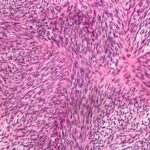
Sarcomas are heterogeneous group of tumours of the connective tissue (including fat, nerve, bone, skin and muscle) (Volser 2021). Whilst they account for 1% of all head and neck malignancies, the head and neck region represents 5-10% of all soft tissue sarcomas.
The aim of this systematic review was to report on the distribution of histological subtypes, treatment and overall survival (OS) rates of head and neck sacomas.
Methods
An electronic database search of PubMed and Embase was undertaken from 2000-2018 to include studies reporting patient databases of soft tissue sarcomas in the head and neck with a minimum of 20 patients (>18 years at diagnosis). Both localised and metastatic disease were included. Patients with radiation induced sarcoma, bone sarcomas and studies which only reported specific histological subtypes were excluded.
Results
- 8 studies were included from 6 different countries comprising 1120 cases. 66% of patients were male and the median age ranged from 35-68.5 years.
- Sarcomas with unidentified histology (n=215) and uncommon sarcoma subtypes (n=141) constituted one-third of the cohort (n=1083). These were followed by fibrosarcomas/fibromatous sarcomas (n=136), vascular sarcomas (n=125) and leiyomyosarcomas (n=89). The uncommon sarcoma subgroup consisted of several sarcomas such as rhabdomyosarcoma (grouped into uncommon as several of the studies had a small number of cases).
- In 57% of cases, the tumour diameter was <5cm at the time of diagnosis and the mean tumour size ranged from 2.7-4.8cm.
- 84% of tumours were grade 3, 7% grade 2 and 5% grade 1 with 3% unspecified or of unknown grade.
- 7 studies (n=1092) reported surgical resection margins; 60% had clear margins, 13% had microscopically involved margins and 18% had macroscopically involved margins. 1% had unknown margins.
- The 5-year overall survival (OS) was reported in 5 studies; 74% (95%CI; 63 to 84%) and the 5-year disease free survival (DFS) was 56% (95%CI ; 38 to 74%).
Conclusions
The authors concluded:-
The pooled results showed a 5-year OS of approximately 75% and 5-year DFS of nearly 50%.
Comments
There are limited conclusions which can be drawn from this systematic review given a range of confounding factors that would impact on overall- and disease free-survival. These will include (but are not limited to) histological type, patient co-morbidities, treatment, adjuvant chemo-radiotherapy, differences in treatment approach per country, Tumour Node Metastasis (TNM) score on first presentation amongst others. There is considerable heterogeneity both in the cancer biology and its clinical course amongst soft tissue sarcomas hence a pooled analysis will only provide limited insight. It was interesting to see the high number of sarcomas that were unidentified and further analysis on causes for this would be useful.
References
Primary reference
Sakshi Andersen, Henriette Mann, Anders Krarup-Hansen, Christel Bræmer Lajer, Christian Grønhøj, “Patient and Tumour Characteristics of Adult Head and Neck Soft Tissue Sarcomas: A Systematic Review and Meta-Analysis”, Sarcoma, vol. 2019, Article ID 9725637, 8 pages, 2019. https://doi.org/10.1155/2019/9725637
Other references
Volser, P (2021). Sarcoma of the head and neck. (accessed 01/07/2021).
Picture Credits
By Nephron – Own work, CC BY-SA 3.0
